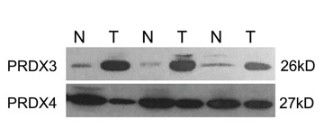- 靶点:
- PRX III
- 基因名称:
- PRDX3
- 蛋白名称:
- Thioredoxin-dependent peroxide reductase mitochondrial
- Human Gene Id:
- 10935
- Human Swiss Prot No:
- P30048
- Mouse Gene Id:
- 11757
- Mouse Swiss Prot No:
- P20108
- Rat Gene Id:
- 64371
- Rat Swiss Prot No:
- Q9Z0V6
- 免疫原:
- The antiserum was produced against synthesized peptide derived from human PRX III. AA range:44-93
- 特异性:
- PRX III Polyclonal Antibody detects endogenous levels of PRX III protein.
- 组成:
- Liquid in PBS containing 50% glycerol, 0.5% BSA and 0.02% sodium azide.
- 来源:
- Polyclonal, Rabbit,IgG
- 稀释:
- WB 1:500 - 1:2000.IHC:1:50-300 IP 1:50-200 ELISA: 1:20000.. IF 1:50-200
- 纯化工艺:
- The antibody was affinity-purified from rabbit antiserum by affinity-chromatography using epitope-specific immunogen.
- 浓度:
- 1 mg/ml
- 储存:
- -15°C to -25°C/1 year(Do not lower than -25°C)
- 其他名称:
- PRDX3;AOP1;Thioredoxin-dependent peroxide reductase; mitochondrial;Antioxidant protein 1;AOP-1;HBC189;Peroxiredoxin III;Prx-III;Peroxiredoxin-3;Protein MER5 homolog
- 实测条带:
- 26kD
- 背景:
- This gene encodes a mitochondrial protein with antioxidant function. The protein is similar to the C22 subunit of Salmonella typhimurium alkylhydroperoxide reductase, and it can rescue bacterial resistance to alkylhydroperoxide in E. coli that lack the C22 subunit. The human and mouse genes are highly conserved, and they map to the regions syntenic between mouse and human chromosomes. Sequence comparisons with recently cloned mammalian homologs suggest that these genes consist of a family that is responsible for the regulation of cellular proliferation, differentiation and antioxidant functions. This family member can protect cells from oxidative stress, and it can promote cell survival in prostate cancer. Alternative splicing of this gene results in multiple transcript variants. Related pseudogenes have been identified on chromosomes 1, 3, 13 and 22. [provided by RefSeq, Oct 2014],
- 功能:
- catalytic activity:2 R'-SH + ROOH = R'-S-S-R' + H(2)O + ROH.,function:Involved in redox regulation of the cell. Protects radical-sensitive enzymes from oxidative damage by a radical-generating system. Acts synergistically with MAP3K13 to regulate the activation of NF-kappa-B in the cytosol.,miscellaneous:Irreversibly inactivated by overoxidation of Cys-108 (to Cys-SO(3)H) upon oxidative stress.,miscellaneous:The active site is the redox-active Cys-108 oxidized to Cys-SOH. Cys-SOH rapidly reacts with Cys-229-SH of the other subunit to form an intermolecular disulfide with a concomitant homodimer formation. The enzyme may be subsequently regenerated by reduction of the disulfide by thioredoxin.,similarity:Belongs to the ahpC/TSA family.,similarity:Contains 1 thioredoxin domain.,subunit:Homodimer; disulfide-linked, upon oxidation (By similarity). Binds MAP3K13.,
- 细胞定位:
- Mitochondrion . Cytoplasm . Early endosome . Localizes to early endosomes in a RPS6KC1-dependent manner. .
- 组织表达:
- Blood,Bone marrow,Brain,Cajal-Retzius cell,Cerebellum,Fetal brain cortex,Liver,Lung,Skeleta
Hydrogen peroxide mediated mitochondrial UNG1-PRDX3 interaction and UNG1 degradation. FREE RADICAL BIOLOGY AND MEDICINE Free Radical Bio Med. 2016 Oct;99:54 Pulled Down Human A549 cell
货号:YT3873
Differential expression of peroxiredoxin 3 in laryngeal squamous cell carcinoma. Oncotarget Oncotarget. 2017 Jan 10; 8(2): 3471–3480 WB Human laryngeal squamous cell carcinoma (LSCC) tissues Hep-2 cell
货号:YT3873
- June 19-2018
- WESTERN IMMUNOBLOTTING PROTOCOL
- June 19-2018
- IMMUNOHISTOCHEMISTRY-PARAFFIN PROTOCOL
- June 19-2018
- IMMUNOFLUORESCENCE PROTOCOL
- September 08-2020
- FLOW-CYTOMEYRT-PROTOCOL
- May 20-2022
- Cell-Based ELISA│解您多样本WB检测之困扰
- July 13-2018
- CELL-BASED-ELISA-PROTOCOL-FOR-ACETYL-PROTEIN
- July 13-2018
- CELL-BASED-ELISA-PROTOCOL-FOR-PHOSPHO-PROTEIN
- July 13-2018
- Antibody-FAQs
- 产品图片

- Zhang, Hua, et al. "Differential expression of peroxiredoxin 3 in laryngeal squamous cell carcinoma." Oncotarget 8.2 (2017): 3471.

- Western Blot analysis of various cells using PRX III Polyclonal Antibody diluted at 1:1000

- Immunohistochemistry analysis of PRX III antibody in paraffin-embedded human lung carcinoma tissue.

- Western blot analysis of lysate from HeLa cells, using PRX III antibody.



